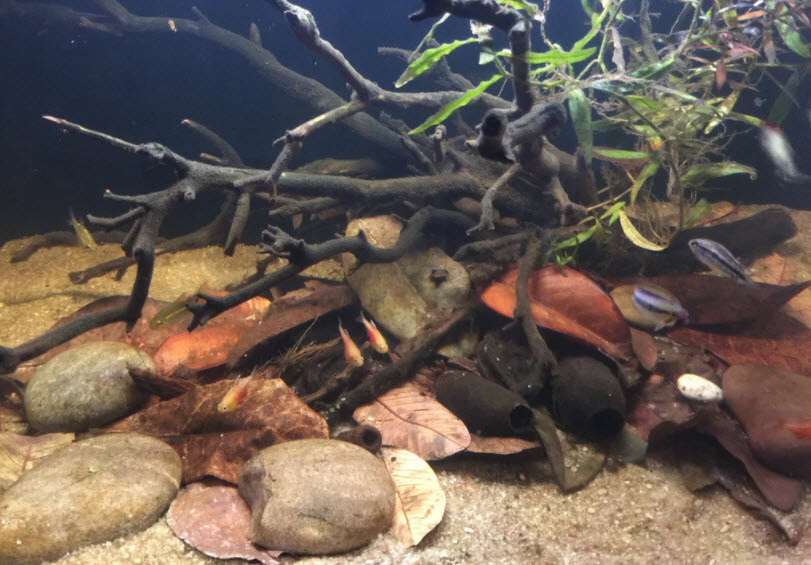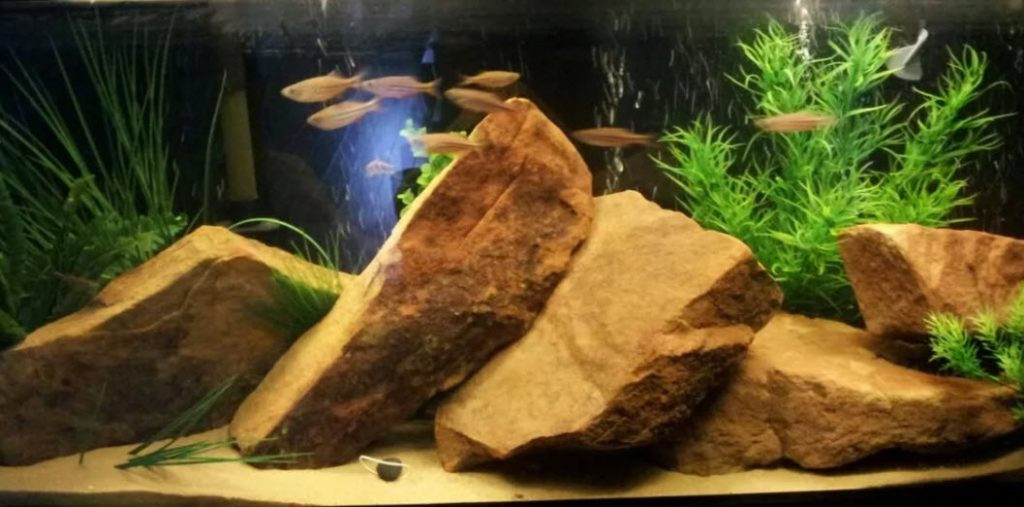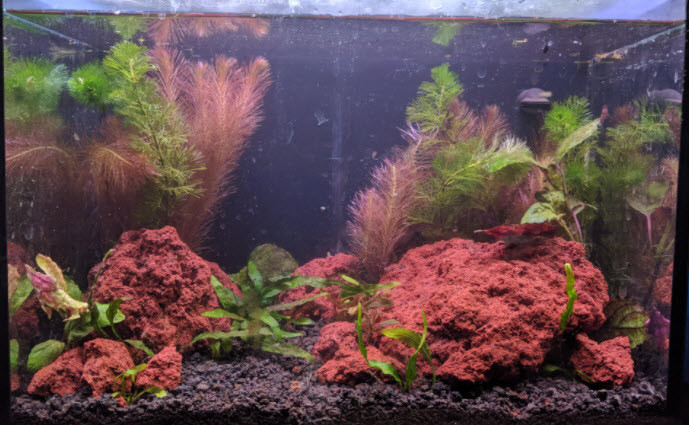Thinking of adding some natural flair to your aquarium? You absolutely can use rocks you find outside in your fish tank! It’s a great way to create a unique and natural-looking environment for your aquatic pets. However, it’s crucial to take the right steps to ensure the rocks are safe for your fish. At rockscapes.net, we’re passionate about helping you create stunning and healthy aquascapes. By carefully selecting and preparing your rocks, you can avoid introducing harmful substances and ensure a thriving aquatic ecosystem.
1. What Types of Rocks Are Safe for Aquariums?
Most rocks found outside are generally safe for aquarium use, but it’s essential to know what to look for and what to avoid. The key is to choose rocks that are inert, meaning they won’t react with the water or leach harmful substances. According to research from Arizona State University’s School of Earth and Space Exploration, silicate-based rocks like quartz, granite, and basalt are usually safe choices.
Here’s a breakdown of common rock types and their suitability for aquariums:
- Quartz: This is a hard, inert mineral that is generally safe for aquariums. It comes in various colors, including clear, white, rose, and smoky.
- Granite: A common igneous rock composed mainly of quartz and feldspar. It’s durable and inert, making it a good choice.
- Basalt: A dark-colored volcanic rock that is also typically safe. It’s known for its hardness and resistance to weathering.
- Slate: A fine-grained metamorphic rock that can add a natural look to your aquarium. Make sure it’s free of any metallic inclusions.
- River Rock: These are typically smooth and rounded due to water erosion. They are generally safe if properly cleaned.
 River Rocks in an Aquarium
River Rocks in an Aquarium
2. What Rocks Should I Avoid Placing in My Aquarium?
While many rocks are safe, some types can be detrimental to your aquarium’s health. Avoid rocks that contain heavy metals, are high in carbonates, or are soft and crumbly. Steer clear of rocks from industrial or mining areas, as they may contain pollutants.
Here’s a list of rocks to avoid:
- Limestone: This rock contains calcium carbonate, which can raise the pH and hardness of your aquarium water. While this might be suitable for some fish, it’s not ideal for all species.
- Marble: Similar to limestone, marble can also affect water chemistry due to its calcium carbonate content.
- Shells: Like limestone and marble, seashells are primarily calcium carbonate and can alter water parameters.
- Malachite and Azurite: These minerals contain copper, which is toxic to fish and invertebrates.
- Rocks with Metallic Veins: Avoid rocks with visible metallic veins, as these may leach harmful metals into the water.
3. How Do I Test a Rock to See if it is Aquarium Safe?
Before placing any rock in your aquarium, it’s essential to test it for safety. The vinegar test is a simple way to check if a rock contains calcium carbonate. However, as research from Arizona State University’s School of Earth and Space Exploration indicates, the vinegar test may not always be accurate.
Here’s how to perform the vinegar test:
- Place the rock in a clean container.
- Pour white vinegar (5% acetic acid) directly onto the rock.
- Observe the rock for any fizzing or bubbling.
If the rock fizzes, it contains calcium carbonate and may raise the pH and hardness of your aquarium water. If there is no reaction, the rock is likely safe to use. For a more accurate test, you can use a stronger acid like hydrochloric acid (pool acid), but exercise caution when handling strong acids.
4. Is It Necessary to Boil or Bleach Rocks Before Putting Them in the Aquarium?
While it might seem like a good idea to boil or bleach rocks to sterilize them, it’s generally not necessary and can even be harmful. According to aquariumscience.org, boiling rocks can cause them to explode if they have air pockets inside. Bleach can also leave harmful residues that are difficult to remove.
Instead, focus on thorough cleaning:
- Scrub the rocks with a stiff brush to remove any dirt, algae, or debris.
- Rinse the rocks thoroughly under running water.
- If desired, soak the rocks in a bucket of water for a few days, changing the water daily.
5. What Are Some Myths About Rocks in Aquariums?
There are many misconceptions about which rocks are safe to use in aquariums. One common myth is that rocks with “sparkles” or iron are poisonous. According to aquariumscience.org, the sparkles are usually mica, an insoluble silicate that is safe for aquariums. Iron oxide (rust) is also harmless.
Another myth is that certain gemstones and semi-precious stones are poisonous. Most gemstones are inert and non-poisonous, so they are safe to use in your aquarium. The key is to do your research and avoid any rocks that are known to contain harmful substances.
6. Can Rocks Affect Aquarium Water Chemistry?
Yes, certain rocks can affect aquarium water chemistry, particularly pH and hardness. Rocks containing calcium carbonate, like limestone and marble, can raise the pH and hardness of the water. This might be beneficial for fish that prefer hard, alkaline water, such as African cichlids. However, it can be detrimental to fish that prefer soft, acidic water, such as tetras andDiscus.
It’s essential to choose rocks that are compatible with the needs of your fish. If you’re unsure, it’s best to stick with inert rocks like quartz, granite, and basalt. Regularly test your aquarium water to monitor pH, hardness, and other parameters.
7. What are the Benefits of Using Natural Rocks in Aquariums?
Using natural rocks in aquariums offers several benefits:
- Aesthetics: Natural rocks can add a beautiful and realistic touch to your aquarium, creating a more visually appealing environment for both you and your fish.
- Hiding Places: Rocks provide hiding places and territories for fish, reducing stress and promoting natural behaviors.
- Biological Filtration: Rocks can provide a surface area for beneficial bacteria to colonize, contributing to biological filtration and helping to maintain water quality.
- Weight and Stability: Large rocks can help anchor driftwood and other decorations, preventing them from floating around the tank.
8. How Do I Clean Porous Rocks for My Fish Tank?
Porous rocks, like lava rock, can be a great addition to your aquarium, providing a large surface area for beneficial bacteria to colonize. However, they can also trap debris and pollutants if not properly cleaned.
Here’s how to clean porous rocks:
- Rinse the rocks thoroughly under running water to remove any loose debris.
- Use a stiff brush to scrub the rocks and remove any stubborn dirt or algae.
- Soak the rocks in a bucket of water for a few days, changing the water daily.
- If desired, you can soak the rocks in a solution of hydrogen peroxide to kill any remaining bacteria or algae. Be sure to rinse the rocks thoroughly before placing them in your aquarium.
 Lava Rock in the Aquarium
Lava Rock in the Aquarium
9. Can I Use Rocks from the Beach in My Fish Tank?
While rocks from the beach can be visually appealing, it’s essential to exercise caution when using them in your aquarium. Beach rocks may contain salt, pollutants, and other harmful substances. If you choose to use beach rocks, follow these steps:
- Rinse the rocks thoroughly with fresh water to remove any salt and debris.
- Soak the rocks in a bucket of fresh water for several weeks, changing the water regularly.
- Test the rocks for any signs of salt or other contaminants before placing them in your aquarium.
It’s generally safer to use rocks from other sources, such as rivers, streams, or rock yards.
10. How Do I Create a Rockscape in My Aquarium?
Creating a rockscape in your aquarium can be a fun and rewarding experience. Here are some tips to help you get started:
- Plan your layout: Before adding any rocks to your aquarium, plan your layout. Consider the size and shape of your tank, the needs of your fish, and your personal preferences.
- Choose your rocks: Select rocks that are safe, inert, and visually appealing. Consider using a variety of sizes and shapes to create a more natural look.
- Clean your rocks: Thoroughly clean your rocks before adding them to your aquarium.
- Arrange your rocks: Arrange your rocks in a way that provides hiding places, territories, and visual interest. Use aquarium-safe silicone to secure the rocks in place if necessary.
- Add your substrate: Add your substrate (gravel, sand, etc.) around the rocks.
- Fill your tank: Slowly fill your tank with water, being careful not to disturb the rocks or substrate.
- Cycle your tank: Cycle your tank before adding any fish. This will allow beneficial bacteria to colonize and establish a healthy ecosystem.
11. Can I Put Crystals and Geodes Inside My Aquarium?
Most naturally occurring crystals are made from quartz, and almost all geodes are quartz. According to aquariumscience.org, quartz makes up about one-fourth of the rocks on the surface of the earth, which is what sand is made of. Claiming that crystals or geodes leach poisonous metals is simply incorrect. However, it’s important to be aware of the potential effects that certain crystals can have on the water’s PH.
Crystals like amethyst, agate, and rose quartz are types of quartz with very minor amounts of harmless impurities very firmly held inside the impermeable quartz matrix. Not only are the impurities harmless, but they also can no more leach out of the quartz than the coloring can be leached out of stained glass windows.
 Amethyst and Citrine Quartz in Aquarium
Amethyst and Citrine Quartz in Aquarium
12. Why Should Rocks with Green Stains be Avoided?
While copper minerals are uncommon, there are a surprising number of small copper ore pockets scattered here and there across the U.S. that typically have been mined out. In the tailings of such small mines, one will find rocks colored green by small amounts of copper silicate minerals. These green rocks are harmless.
If you find a green rock anywhere but in the vicinity of a copper mine, the rock can be colored by any one of many common green silicate minerals. These include peridotite, actinolite, serpentine, olivine, chlorite, glauconite, and pyroxene. These common green silicates are completely harmless.
13. Is it Okay to Put Sandstone in an Aquarium?
According to the aquariumscience.org, many folks have heard that one needs to be careful with some rocks like sandstone and shale because they will fall apart in the water of an aquarium and become sand. A rock that has been exposed to groundwater and rain for at least several thousand years is going to fall apart in a short time in the aquarium.
However, there is a material called “mudstone” which is just dried hardened clay, which will fall apart in the aquarium.
 Sedimentary Sandstone in an Aquarium
Sedimentary Sandstone in an Aquarium
14. Are There Any Drawbacks to Using Lava Rocks in Fish Tanks?
Another commentator, a “degreed geologist” warned that lava rock can have “poisonous” sulfides like pyrite in the matrix. Yes, maybe one in a thousand lava flows have significant amounts of pyrite (iron sulfide) embedded in the silicate mineral matrix. But pyrite is NOT POISONOUS (see discussion above) and only dissolves very slowly when acted on by certain bacteria. Other metallic sulfides such as cinnabar do not occur in lava flows and are not poisonous if they were found.
 lava rock in the aquarium
lava rock in the aquarium
15. What Should I Know About Using Rocks from the Seashore?
The amount of salt found on seashore rocks or coral is minute and harmless. Salt is very soluble, so one won’t have large crystals of salt sitting inside a piece of coral or rock. And note many ascribe to adding salt to a tropical fish tank as a tonic, a harmless practice.
FAQ About Using Outside Rocks in a Fish Tank
1. Can I use any rock I find outside in my aquarium?
While many rocks are safe, it’s crucial to avoid those containing heavy metals or high levels of carbonates like limestone. Testing the rock with vinegar can help determine its suitability.
2. Does boiling rocks make them safe for aquariums?
Boiling is generally unnecessary and can be dangerous, potentially causing rocks to explode. Thorough cleaning is usually sufficient.
3. How do I clean rocks before putting them in my aquarium?
Scrub the rocks with a stiff brush and rinse them thoroughly under running water. Soaking them in a bucket of water for a few days can also help remove any remaining debris.
4. Are sparkly rocks safe for aquariums?
The sparkles are usually mica, an insoluble silicate that is safe for aquariums. Iron oxide (rust) is also harmless.
5. Can rocks affect my aquarium’s water chemistry?
Yes, rocks containing calcium carbonate can raise the pH and hardness of the water. This might be beneficial for some fish but detrimental to others.
6. What are the benefits of using natural rocks in aquariums?
Natural rocks add aesthetic appeal, provide hiding places for fish, contribute to biological filtration, and offer weight and stability to decorations.
7. How do I clean porous rocks for my fish tank?
Rinse thoroughly, scrub with a stiff brush, and soak in water for a few days. A hydrogen peroxide solution can also be used for disinfection.
8. Can I use rocks from the beach in my fish tank?
Beach rocks may contain salt and pollutants. If used, rinse thoroughly, soak in fresh water for several weeks, and test for contaminants.
9. How do I create a rockscape in my aquarium?
Plan your layout, select safe and visually appealing rocks, clean them thoroughly, arrange them to provide hiding places, add substrate, and cycle the tank.
10. What’s the best type of glue to use when making an aquascape?
Cyanoacrylate glue is great for using above water, or gluing smaller plants. Aquarium safe silicone sealant is another option for larger projects.
Using rocks from the great outdoors can bring a touch of nature to your aquarium, enhancing its beauty and creating a more natural environment for your fish. By following these guidelines, you can confidently select, prepare, and use outside rocks in your fish tank, ensuring a healthy and stunning aquatic landscape.
Ready to transform your aquarium into a breathtaking underwater paradise? Visit rockscapes.net today for inspiration, expert advice, and a wide selection of aquarium-safe rocks and decorations. Let us help you create the aquarium of your dreams! Contact us at Address: 1151 S Forest Ave, Tempe, AZ 85281, United States. Phone: +1 (480) 965-9011 or visit our Website: rockscapes.net.